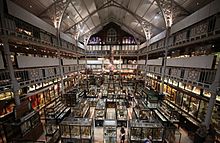Pitt Rivers Museum

Pitt Rivers Museum interior
|
|
| Established | 1884 |
|---|---|
| Location | Parks Road, Oxford, England |
| Coordinates | 51°45′31″N 1°15′18″W / 51.7586°N 1.2550°WCoordinates: 51°45′31″N 1°15′18″W / 51.7586°N 1.2550°W |
| Type | University museum of archaeology and anthropology |
| Website | http://www.prm.ox.ac.uk |
The Pitt Rivers Museum is a museum displaying the archaeological and anthropological collections of the University of Oxford in Oxford, England. The museum is located to the east of the Oxford University Museum of Natural History, and can only be accessed through that building.
The museum was founded in 1884 by Lt-General Augustus Pitt Rivers, who donated his collection to the University of Oxford with the condition that a permanent lecturer in anthropology must be appointed. Museum staff are involved in teaching Archaeology and Anthropology at the University even today. The first Curator of the Museum was Henry Balfour. A second stipulation in the Deed of Gift was that a building should be provided to house the collection and used for no other purpose. The University therefore engaged Thomas Manly Deane, son of Thomas Newenham Deane who, together with Benjamin Woodward, had designed and built the original Oxford University Museum of Natural History building three decades earlier, to create an adjoining building at the rear of the main building to house the collection. Construction started in 1885 and was completed in 1886.
The original donation consisted of approximately 22,000 items; this has now grown to 500,000 items, many of which have been donated by travellers, scholars and missionaries.
The museum's collection is arranged thematically, according to how the objects were used, rather than according to their age or origin. This layout owes a lot to the theories of Pitt Rivers himself, who intended for his collection to show progression in design and evolution in human culture from the simple to the complex. Whilst this evolutionary approach to material culture is no longer fashionable in archaeology and anthropology, the museum has retained the original organisation of the displays. The display of many examples of a particular type of tool or artifact, showing historical and regional variations, is an unusual and distinct feature of this museum.
...
Wikipedia

